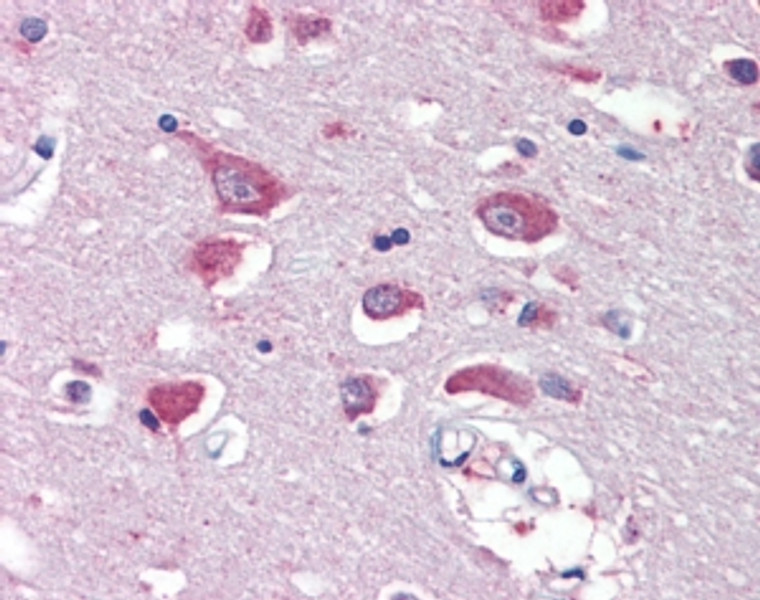| Host: |
Goat |
| Applications: |
Pep-ELISA/WB/IHC |
| Reactivity: |
Human/Mouse/Rat/Cow |
| Note: |
STRICTLY FOR FURTHER SCIENTIFIC RESEARCH USE ONLY (RUO). MUST NOT TO BE USED IN DIAGNOSTIC OR THERAPEUTIC APPLICATIONS. |
| Short Description: |
Goat polyclonal antibody anti-GRIA4 (Internal) is suitable for use in ELISA, Western Blot and Immunohistochemistry research applications. |
| Clonality: |
Polyclonal |
| Conjugation: |
Unconjugated |
| Isotype: |
IgG |
| Formulation: |
0.5 mg/ml in Tris saline, 0.02% sodium azide, pH7.3 with 0.5% bovine serum albumin. NA |
| Purification: |
Purified from goat serum by ammonium sulphate precipitation followed by antigen affinity chromatography using the immunizing peptide. |
| Concentration: |
0.5 mg/mL |
| Dilution Range: |
WB-1-2µg/mlIHC-Recommended concentration, 5-10µg/mlELISA-antibody detection limit dilution 1:128000. |
| Storage Instruction: |
Store at-20°C on receipt and minimise freeze-thaw cycles. |
| Gene Symbol: |
GRIA4 |
| Gene ID: |
2893 |
| Uniprot ID: |
GRIA4_HUMAN |
| Immunogen Region: |
Internal |
| Accession Number: |
NP_000820.3; NP_001070711.2; NP_001070712.1 |
| Specificity: |
This antibody is expected to recognize all reported isforms (NP_000820.3; NP_001070711.1; NP_001070712.1). Reported variants NP_001070712.1 and NP_001106283.1 represent identical protein. |
| Immunogen Sequence: |
KKLDQREYPGSETP |
| Function | Receptor for glutamate that functions as ligand-gated ion channel in the central nervous system and plays an important role in excitatory synaptic transmission. L-glutamate acts as an excitatory neurotransmitter at many synapses in the central nervous system. Binding of the excitatory neurotransmitter L-glutamate induces a conformation change, leading to the opening of the cation channel, and thereby converts the chemical signal to an electrical impulse. The receptor then desensitizes rapidly and enters a transient inactive state, characterized by the presence of bound agonist. In the presence of CACNG4 or CACNG7 or CACNG8, shows resensitization which is characterized by a delayed accumulation of current flux upon continued application of glutamate. |
| Protein Name | Glutamate Receptor 4Glur-4Glur4Ampa-Selective Glutamate Receptor 4Glur-DGlutamate Receptor Ionotropic - Ampa 4Glua4 |
| Database Links | Reactome: R-HSA-399710Reactome: R-HSA-399719Reactome: R-HSA-416993Reactome: R-HSA-438066Reactome: R-HSA-8849932 |
| Cellular Localisation | Cell MembraneMulti-Pass Membrane ProteinPostsynaptic Cell MembraneCell ProjectionDendriteInteraction With Cnih2Cnih3 And Prkcg Promotes Cell Surface Expression |
| Alternative Antibody Names | Anti-Glutamate Receptor 4 antibodyAnti-Glur-4 antibodyAnti-Glur4 antibodyAnti-Ampa-Selective Glutamate Receptor 4 antibodyAnti-Glur-D antibodyAnti-Glutamate Receptor Ionotropic - Ampa 4 antibodyAnti-Glua4 antibodyAnti-GRIA4 antibodyAnti-GLUR4 antibody |
Information sourced from Uniprot.org
12 months for antibodies. 6 months for ELISA Kits. Please see website T&Cs for further guidance








